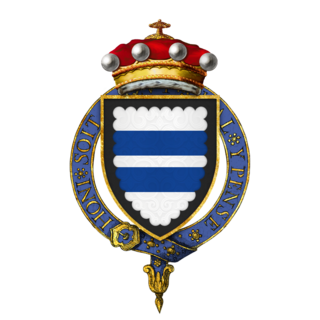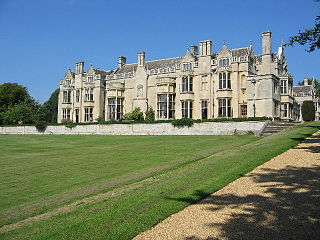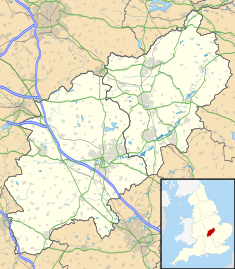
Edward de Vere, 17th Earl of Oxford was an English peer and courtier of the Elizabethan era. Oxford was heir to the second oldest earldom in the kingdom, a court favourite for a time, a sought-after patron of the arts, and noted by his contemporaries as a lyric poet and court playwright, but his volatile temperament precluded him from attaining any courtly or governmental responsibility and contributed to the dissipation of his estate.

Duke of Sutherland is a title in the Peerage of the United Kingdom which was created by William IV in 1833 for George Leveson-Gower, 2nd Marquess of Stafford. A series of marriages to heiresses by members of the Leveson-Gower family made the Dukes of Sutherland one of the richest landowning families in the United Kingdom. The title remained in the Leveson-Gower family until the death of the 5th Duke of Sutherland in 1963, when it passed to the 5th Earl of Ellesmere from the Egerton family.
Francis Tresham, eldest son of Thomas Tresham and Muriel Throckmorton, was a member of the group of English provincial Catholics who planned the failed Gunpowder Plot of 1605, a conspiracy to assassinate King James I of England.
Sir Thomas Tresham was a leading Catholic politician during the middle of the Tudor dynasty in England.

Sir Thomas Tresham was a prominent recusant Catholic landowner in Elizabethan Northamptonshire. He died two years after the accession of James VI and I.
Sir Thomas Tresham was a British politician, soldier and administrator. He was the son of Sir William Tresham and his wife Isabel de Vaux, daughter of Sir William Vaux of Harrowden. Thomas's early advancement was due to his father's influence. In 1443 he and his father were appointed as stewards to the Duchy of Lancaster's estates in Northamptonshire, Buckinghamshire, Bedfordshire and Huntingdonshire, and by 1446 Thomas was serving as an esquire for Henry VI, being made an usher of the king's chamber in 1455. He was appointed a Justice of the Peace for Huntingdonshire in 1446, a position he held until 1459, and was returned to Parliament for Buckinghamshire in 1447 and Huntingdonshire in 1449. Despite the Tresham family's close links with the royal court they were also on good terms with Richard Plantagenet, 3rd Duke of York, and when he returned from Ireland in 1450 Tresham and his father went to greet him. Shortly after leaving home on 23 September they were attacked by a group of men involved in a property dispute with his father; William Tresham was killed, and Thomas was injured.
Sir William Tresham JP was an English lawyer and Speaker of the House of Commons.

Lyveden New Bield is an unfinished Elizabethan summer house in the parish of Aldwincle in North Northamptonshire, England, owned by the National Trust. It is a Grade I listed building, classing it as a 'building of exceptional interest.'

Hedingham Castle, in the village of Castle Hedingham, Essex, is arguably the best preserved Norman keep in England. The castle fortifications and outbuildings were built around 1100, and the keep around 1140. However, the keep is the only major medieval structure that has survived, albeit less two turrets. It is a Grade I listed building and a scheduled monument. The keep is open to the public.
This is a list of the High Sheriffs of Northamptonshire.
William Parr, 1st Baron Parr of Horton was the son of Sir William Parr and his second wife, the Hon. Elizabeth Fitzhugh, later Lady Vaux of Harrowden.

Sir William Parr, KG (1434–1483) was an English courtier and soldier. He was the eldest son of Sir Thomas Parr (1405–1461) and his wife Alice, daughter of Sir Thomas Tunstall of Thurland, Lancashire.
The Midland Revolt was a popular uprising which occurred in the Midlands of England in 1607. Beginning in late April in Northamptonshire, in Haselbech, Pytchley and Rushton, it spread to Warwickshire and Leicestershire in May. The riots were a protest against the enclosure of common land and drew considerable support, led by "Captain Pouch", otherwise John Reynolds, a tinker said to be from Desborough, Northamptonshire. He claimed authority from the King and Lord of Heaven to destroy enclosures and promised to protect protesters with the contents of his pouch, carried by his side, which would keep them from harm. He urged them to use no violence in their efforts to destroy the enclosures. Three thousand were recorded at Hillmorton, Warwickshire and 5000 at Cotesbach, Leicestershire. A curfew was imposed in Leicester, for fear its citizens would stream out to join the riots. They pulled down a gibbet erected there as a warning. It was also during this period that the term "leveller" was first used.

Sir Thomas Parr of Kendal in Westmorland, England, was a courtier and is best known as the father of Queen Catherine Parr, the sixth and final wife of King Henry VIII.

Rushton is a village and civil parish in Northamptonshire. It is about 2 miles (3.2 km) north-east of Rothwell and 3 miles (4.8 km) north-west of Kettering. The parish covers 3,200 acres (1,300 ha) and is situated on both sides of the River Ise. It contains the sites of three deserted settlements, details of which are set out below.

Sir Robert Throckmorton, KG, of Coughton Court in Warwickshire, was a Member of Parliament and a distinguished English courtier. His public career was impeded by remaining a Roman Catholic.
Elizabeth de Vere, Countess of Oxford, formerly Elizabeth Trentham, was the second wife of the Elizabethan courtier and poet Edward de Vere, 17th Earl of Oxford.
Thomas Trentham (1538–1587) was an English politician.
Elizabeth FitzHugh also known as Lady Elizabeth Parr. She was an English noblewoman and lady-in-waiting to her cousin, Anne Neville, queen consort of King Richard III. She was grandmother of Catherine Parr, sixth queen consort to King Henry VIII, and her siblings Anne Herbert, Countess of Pembroke, and William Parr, 1st Marquess of Northampton.
Thomas Brudenell, 1st Earl of Cardigan, known as Sir Thomas Brudenell, Bt, between 1611 and 1628 and as The Lord Brudenell between 1628 and 1661, was an English peer and Royalist soldier.












